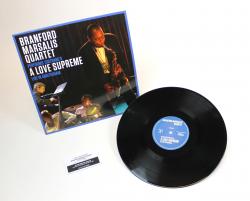 Coltrane’s A Love Supreme: Live in Amsterdam reissue from the Branford Marsalis Quartet out now and available on vinyl for the very first time Read more »
Coltrane’s A Love Supreme: Live in Amsterdam reissue from the Branford Marsalis Quartet out now and available on vinyl for the very first time Read more »
Working Together, Taking Different Roads
Date: 03.05.2003
Publication: New York Times
Author: Ben Ratliff
It’s true: the Marsalises have been overexposed to the ends of the earth. One might have looked at the enormous profile on Wynton Marsalis in the current issue of The Atlantic Monthly, noticed the recent PBS special about the family, then seen a full-family concert coming up and rightly wondered why nobody else in jazz was apparently worth paying attention to.
The family could have played a rigid show; they could have made it cute; it could have been overly pedantic or gone overboard with New Orleans cliché. But “Ellis Marsalis and Sons,” a touring concert that sold out the 2,700-seat Prudential Theater at the New Jersey Performing Arts Center here tonight and didn’t have a Manhattan stop, was so much better than it needed to be.
With the father, Ellis, at the piano, and four of his sons playing beside him ‹ Branford on saxophones, Wynton on trumpet, Delfeayo on trombone and Jason on drums (Reginald Veal played bass) the show roped together distinct musical personalities and let the music talk for itself.
And they had a marvelous group sound, or actually several different ones.
The patriarch is a quietly fearsome pianist: a generator of small gestures, always more rhythmic than you expect. In the spaces where so many other pianists bide their time, he played lean, gentle provocations, playing accompaniment behind his sons’ solos for example. When it came time to shine, as in his solo during Alvin Batiste’s “Mozart-In’,” he contributed a furtive, mumbling blues solo.
That same song also gave the youngest family member onstage, Jason, a turn to demonstrate what he has. He is one of the cleanest drummers in jazz, and intensely conceptual. He rarely rests on patterns you’ve often heard and thinks like an arranger, in discrete compartments of music. Here he played in dragging New Orleans parade rhythm, varying his muted drum sounds and keeping loud cymbals out of it. It was open, spacious and tremendously funky.
Wisely, the concert used several group permutations: a piano-trio (Ellis Marsalis’s slow ballad “After”), a quartet with Wynton and Branford playing at full bore (on Branford’s “Cain and Abel”), a trombone-piano duet (Delfeayo’s “If You Only Knew”) and pieces with the full sextet. At times the family played with an almost classical sense of restraint; as a result the music seemed restricted by the barrier of the stage; at other times the music gushed over the audience or incorporated unconventional structures. (“Down Home With Homey” ended with a vigorous bass solo.)
At times Wynton and Branford were like a fork in jazz’s road. The trumpeter often used sleek, orderly patterns to win over the audience, as he did at the start of “Buddy Bolden’s Blues,” when an unaccompanied eighth-note solo seemed nearly Baroque in its tight, consonant structure.
When the saxophonist went for broke, he grew expansive, loud and nearly messy, smashing through the walls of harmony, getting very post-Coltrane for an audience that might not have been seeking a challenge. What a relief that a concert like this could contain both impulses and many others.
Categories
Tags in Tags
Branford Marsalis Branford Marsalis Quartet ellis marsalis four mfs playin' tunes Joey Calderazzo Justin Faulkner Marsalis Family marsalis music metamorphosen miguel zenon music redeems new orleansFilter by Artist
Marsalis Music Radio
Join Our Mailing List
- RT @bmarsalis: Compliments of the @T_Blanchard archives. https://t.co/4RsXbyEloa — 3 years 9 weeks ago MarsalisMusic